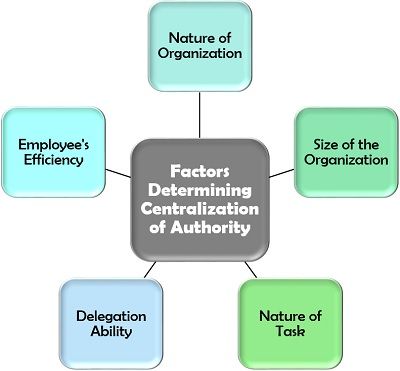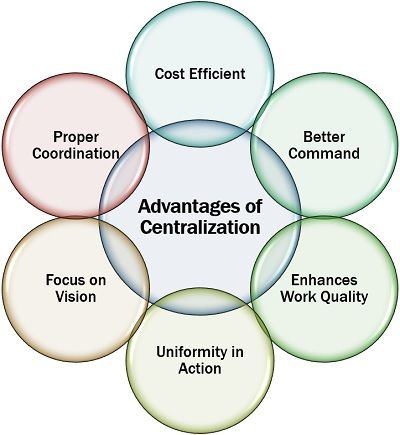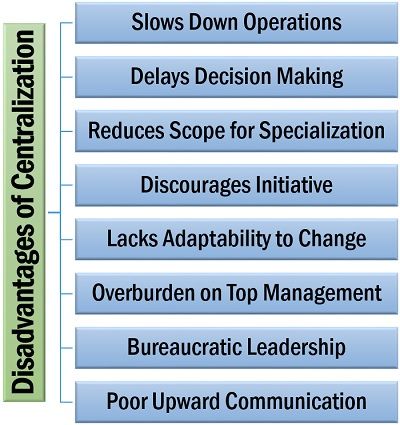Definition: Centralization refers to that organizational structure where decision-making power is confined to the top management, and the subordinates need to follow the instructions of their seniors. Centralization of authority is essential for the small-scale organizations which lack resources and finance.
Example: A person running a departmental store appoints a manager, a cleaning staff, a salesperson and a helper. The owner delegates the work among the staff according to their skills and positions.
However, he retains the decision making authority related to display, discounts, offers, stock, orders, workers’ salary, leaves and increment with him. He also keeps firm control over the routine activities of the staff and instructs them from time to time.
This type of organization has a decentralized structure where the owner is the decision-maker, and the staff has to follow his instructions.
Content: Centralization
Factors Determining Centralization of Authority
In small organizations, the owner or the top management is responsible for making all the business decision solely. Whereas, the delegation of work among the subordinates takes place; therefore, centralization persists in these business units.
The following factors result in the centralization of the organization:
- Nature of Organization: When the organization is generally a sole proprietorship or partnership entity with less number of employees to be managed, it can have a centralized system.
- Size of the Organization: The organization which are small in size and operating on a small scale can be efficiently managed by the top management hence following a centralized system.
- Nature of Task: The organizations engaged in business operations which does not require much expertise or specialization, can be managed through centralization.
- Delegation Ability: The capability of the management to delegate the responsibilities to the subordinates while keeping the charge in their hand is another factor determining the organizational structure.
- Employee’s Efficiency: If the employees lack skills and efficiency to take up the responsibility and accountability of the work to be performed, the management will go for centralization of the organization.
Advantages of Centralization
You must be wondering; What is the need for centralization of authority in an organization? Why can’t all the organizations be decentralized?
Yes, centralization and decentralization are equally crucial for a business. The reasons for which some o organizations mainly centralizes its structure are as follows:
Cost Efficient: The management need not spend much on the office and administrative expenses in a centralized organization. Even the cost of hiring experts and highly experienced personnel at each level is saved due to the centralized decision-making process.
Better Command: The management can hold a better command over the subordinates and the subordinates also clearly know whom to follow. There is proper control over the subordinate actions, and the management is well aware of the strengths and weaknesses of the subordinates.
Enhances Work Quality: The subordinates are answerable directly to the top management, and therefore they continuously aim at improving the work quality. It also leads to standardization of the process and reduces the wastage.
Uniformity in Action: When the control lies in the hands of few, the methods and techniques used are usually the same throughout all the levels and departments, thus encouraging the subordinates to perform uniformly.
Focus on Vision: The top management clearly defines and better understand the organizational vision. Therefore, it aligns all the resources, subordinates, activities and strategies towards the achievement of the vision.
Proper Coordination: The top management frames a uniform policy for subordinates at different levels, integrate their course of action and ensures coordination among all the subordinates.
Disadvantages of Centralization
Centralization is not suitable for all type of business organizations. When we talk about a brand like Nestle, it wouldn’t have expanded its business to such a vast extent if it had a centralized organizational structure.
Let us now discuss the various shortcomings of centralization in an organization:
Slows Down Operations: The top management directs the day to day operations, and the subordinates have to report directly to the senior management. At times when there is no managerial staff, the subordinates are unable to take immediate decisions. Thus, resulting in slowing down of business operations.
Delays Decision Making: In centralization, the decision-making process slows down since all the decisions are to be taken by the top management. It is not suitable for handling emergencies or unexpected circumstances.
Reduces Scope for Specialization: A person cannot specialize in all the activities alone. Therefore, in a centralized structure where all decisions are taken by the top management, the organization lacks specialized supervision and management.
Discourages Initiative: The subordinates are given instructions which they need to follow without questioning the decisions of the top management. In centralization, the subordinates are intimidated from giving their input or suggestions.
Lacks Adaptability to Change: The centralized organization runs in a conventional manner where the top management is somewhat rigid with its policies, methods and techniques. Thus, it creates a barrier to adopting modern and improved practices for organizational growth.
Overburden on Top Management: All the planning and decision-making work is done at the topmost level of management, they control even the day to day operations. Due to this reason, management becomes overburdened and is unable to concentrate on business expansion and growth.
Bureaucratic Leadership: Centralization can be seen as a dictatorship by some, where the top management plans every course of action and the subordinates follow the instructions. Problem-solving becomes quite difficult in such circumstances since the decision-maker, and the implementer is two different individuals.
Poor Upward Communication: The subordinates are supposed to follow instructions while the least attention is paid towards their suggestions and feedback. All this hinders the upward communication in the organization.
Conclusion
Centralization is taken as a dominating or dictatorial practice nowadays. The reason may be that the current employees do not like to be ruled. Instead, they feel more comfortable in the organizations which treat employees as their associates and value their knowledge, skills and suggestions.
However, from the organizational point of view, centralization is essential to keep a hold over the business activities and operations, especially in the organizations where the employees are not self-disciplined or do possess the required decision-making skills.
Amen A. Motsumi says
that was very helpful..Thank you